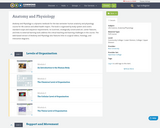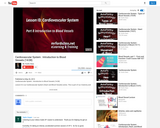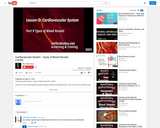
Laboratory manual for undergraduate Anatomy & Physiology 2
- Subject:
- Anatomy/Physiology
- Biology
- Health, Medicine and Nursing
- Material Type:
- Activity/Lab
- Reading
- Teaching/Learning Strategy
- Textbook
- Author:
- Julie Robinson
- Date Added:
- 07/30/2022

Laboratory manual for undergraduate Anatomy & Physiology 2

Anatomy and Physiology is a dynamic textbook for the two-semester human anatomy and physiology course for life science and allied health majors. The book is organized by body system and covers standard scope and sequence requirements. Its lucid text, strategically constructed art, career features, and links to external learning tools address the critical teaching and learning challenges in the course. The web-based version of Anatomy and Physiology also features links to surgical videos, histology, and interactive diagrams.


As taught Semesters 1 and 2, 2011
This learning object explains and describes how the structure of a blood vessel is related to its function. This learning object is used as part of the level 1 Biological Sciences module delivered by the School of Nursing, Midwifery and Physiotherapy.
Dr Andy Meal, Lecturer in Biological Sciences, School of Nursing, Midwifery and Physiotherapy

This video kicks off the blood vessels series. The concepts covered in this video include:
-The functions of the cardiovascular system
-The components of the cardiovascular system
-The major divisions of the cardiovascular system: pulmonary circuit and systemic circuit
Lesson 8 in our Cardiovascular System (Heart and Blood Vessels) series. This is part of our Anatomy and Physiology lecture series.
If this video helps you please be sure to LST -like subscribe and tell your friends. Your support helps us make more videos. For the complete series please visit http://mrfordsclass.net/
Blood Videos
-Introduction to Blood (13:01): http://youtu.be/-Y5U49E-CM4
-Composition of Blood (13:02): http://youtu.be/YHCIMKZ0zrg
-Hematopoiesis-Making Blood (13:03): http://youtu.be/sibrcrXHJGI
-Red Blood Cells (13:04): http://youtu.be/19_6kUCVYfk
Heart and Blood Vessels Videos
-Heart Fundamentals (14:01): http://youtu.be/Y335KJ-EuDw
-Layers of the Heart (14:02): http://youtu.be/8PlwFTwJRMQ
-Chambers in the Heart (14:03): http://youtu.be/SdNQtPzUfHg
-Introduction to Blood Vessels (14:08): http://youtu.be/GVs8cd6jv94
-Types of Blood Vessels (14:09): http://youtu.be/_jkQR8v-bAg
-Movement of Blood (14:11): http://youtu.be/x9dH5TpKntk

This videos looks at the three principles the control the functions of the cardiovascular system. We also look at blood flow, heart actions, blood volume, resistance to flow, blood viscosity and the hematocrit.
All of our videos can be found at http://www.mrfordsclass.net
The concepts covered in this video include:
-Blood flow
-Heart actions
-Blood volume
-Resistance to flow
-Blood viscosity
-Hematocrit
Lesson 11 in our Cardiovascular System (Heart and Blood Vessels) series. This is part of our Anatomy and Physiology lecture series.
If this video helps you please be sure to LST -like subscribe and tell your friends. Your support helps us make more videos. For the complete series please visit http://mrfordsclass.net/
Blood Videos
-Introduction to Blood (13:01): http://youtu.be/-Y5U49E-CM4
-Composition of Blood (13:02): http://youtu.be/YHCIMKZ0zrg
-Hematopoiesis-Making Blood (13:03): http://youtu.be/sibrcrXHJGI
-Red Blood Cells (13:04): http://youtu.be/19_6kUCVYfk
Heart and Blood Vessels Videos
-Heart Fundamentals (14:01): http://youtu.be/Y335KJ-EuDw
-Layers of the Heart (14:02): http://youtu.be/8PlwFTwJRMQ
-Chambers in the Heart (14:03): http://youtu.be/SdNQtPzUfHg
-Introduction to Blood Vessels (14:08): http://youtu.be/GVs8cd6jv94
-Types of Blood Vessels (14:09): http://youtu.be/_jkQR8v-bAg
-Movement of Blood (14:11): http://youtu.be/x9dH5TpKntk

This videos looks at the different types of blood vessels in the cardiovascular system.
The concepts covered in this video include:
•Types of blood vessels
•Arteries
•Arterioles
•Metarterioles
•Capillaries
•Venules
•Veins
•The tunics of the blood vessels
•Tunica Intima/Tunica Interna
•Tunica Media
•Tunica Adventitia/Tunica Externa
Lesson 9 in our Cardiovascular System (Heart and Blood Vessels) series. This is part of our Anatomy and Physiology lecture series.
If this video helps you please be sure to LST -like subscribe and tell your friends. Your support helps us make more videos. For the complete series please visit http://mrfordsclass.net/
Blood Videos
-Introduction to Blood (13:01): http://youtu.be/-Y5U49E-CM4
-Composition of Blood (13:02): http://youtu.be/YHCIMKZ0zrg
-Hematopoiesis-Making Blood (13:03): http://youtu.be/sibrcrXHJGI
-Red Blood Cells (13:04): http://youtu.be/19_6kUCVYfk
Heart and Blood Vessels Videos
-Heart Fundamentals (14:01): http://youtu.be/Y335KJ-EuDw
-Layers of the Heart (14:02): http://youtu.be/8PlwFTwJRMQ
-Chambers in the Heart (14:03): http://youtu.be/SdNQtPzUfHg
-Introduction to Blood Vessels (14:08): http://youtu.be/GVs8cd6jv94
-Types of Blood Vessels (14:09): http://youtu.be/_jkQR8v-bAg
-Movement of Blood (14:11): http://youtu.be/x9dH5TpKntk

This resource is a video abstract of a research paper created by Research Square on behalf of its authors. It provides a synopsis that's easy to understand, and can be used to introduce the topics it covers to students, researchers, and the general public. The video's transcript is also provided in full, with a portion provided below for preview:
"Sound waves. They bring music to our ears, help doctors peer inside our bodies, and even allow us to “see” underwater. Now, scientists are using these versatile packets of vibrating energy for a new application: growing functional, transplantable blood vessels right on the benchtop. These engineered tissues can be used to repair injuries caused by diminished blood flow from blood clots or other blockages. But there’s a lot to consider when fabricating therapeutic blood vessels. There are biological and mechanical attributes that are tricky to get right. The body’s vasculature is complex and multiscale, and a precise geometric arrangement is needed for efficient perfusion. Vessels are also composed of multiple cell types, which need to be well integrated to function. To engineer tissues that meet these requirements, scientists developed a new acoustophoretic cell patterning technique. The method uses sound waves to precisely align cells into user-defined patterns..."
The rest of the transcript, along with a link to the research itself, is available on the resource itself.

This resource is a video abstract of a research paper created by Research Square on behalf of its authors. It provides a synopsis that's easy to understand, and can be used to introduce the topics it covers to students, researchers, and the general public. The video's transcript is also provided in full, with a portion provided below for preview:
"Increased blood flow to the uterus during pregnancy is essential to the health of both mother and baby But the cellular processes that promote blood flow during pregnancy aren’t fully understood Now, researchers have discovered that fat surrounding blood vessels in the uterus plays a key role In pregnant rats, uterine blood flow was up to 3 times higher than in non-pregnant rats But blood flow plummeted when fat tissue was removed from the uterus of pregnant rats Interestingly, tests on isolated vessels demonstrated that fat tissue-shrinking factors could be at play which seems counterintuitive because narrow vessels generally mean low blood flow One explanation is that isolating tissue from its natural surroundings could produce changes not observed in a live animal Future studies will explore this apparent contradiction and hopefully reveal the role of fat tissue in human pregnancy Osikoya et al..."
The rest of the transcript, along with a link to the research itself, is available on the resource itself.

This text been designed for an undergraduate human anatomy and physiology course at a medium sized public university. This text has been modified from the original OpenStax text to encourage more active reading for an early undergraduate student taking the first semester of a year-long human anatomy and physiology course sequence. This text has been targeted to our student population, consisting primarily of first semester pre-nursing and kinesiology majors at a university with a high proportion of first generation and PELL-eligible students who benefit from lower barriers to entry into the field. Therefore, freely-available and differently presented text can be beneficial to this student population. This version was designed with the intention of distributing it section by section through a learning management system. If this mode of distribution is used, connection to an assessment tool could be utilized. Systems covered include skeletal, muscular, cardiovascular, respiratory, and nervous.
As this text reorganizes and modifies an OpenStax’s Anatomy and Physiology 2e (see related resources link below), chapter numbers and chapter section numbers from the original have been preserved in this document. Material supplemented from other sources is cited within the text.
Course connections: Undergraduate courses aimed towards freshmen or sophomore, including Anatomy and Physiology, Introduction to Anatomy and Physiology, Physiology, Introduction to Physiology, Human Biology or similar with a human focus.

This patient education program explains the different types of migraine headache, the causes, symptoms, triggering factors, treatment, and prevention. This resource is a MedlinePlus Interactive Health Tutorial from the National Library of Medicine, designed and developed by the Patient Education Institute.

This resource is a video abstract of a research paper created by Research Square on behalf of its authors. It provides a synopsis that's easy to understand, and can be used to introduce the topics it covers to students, researchers, and the general public. The video's transcript is also provided in full, with a portion provided below for preview:
"Vascular leakage is excessive permeability of blood vessel walls. It’s an inflammatory process associated with illnesses like septic shock and lung injury induced by ischemia or reperfusion. While the mechanism of vascular leakage has remained unclear,a new study suggests that microparticles derived from platelets and endothelial cells could play critical roles. In rats, injection of these microparticles induced pulmonary vascular leakage and lung injury. The microparticles acted synergistically, with endothelial microparticles (EMP) causing platelet buildup, more platelet microparticle (PMP) formation, and further vascular leakage. Experiments showed that certain microRNA (miR) cargo in the microparticles seemed to control the mechanism of injury. Inhibiting miR-155 in endothelial microparticles and miR-126 in platelet microparticles alleviated the effects of the two types of microparticles on vascular leakage and injury..."
The rest of the transcript, along with a link to the research itself, is available on the resource itself.

This resource is a video abstract of a research paper created by Research Square on behalf of its authors. It provides a synopsis that's easy to understand, and can be used to introduce the topics it covers to students, researchers, and the general public. The video's transcript is also provided in full, with a portion provided below for preview:
"Radiation therapy is a powerful way to kill cancer cells or slow their growth, but radiation can have unintended effects on surrounding cells. In a new study, researchers report that X-rays could actually help cancer cells gain a foothold in otherwise healthy tissue. The team blasted breast cancer cells cultured in the lab with different doses of X-rays. The cells released a cocktail of molecules in response including VEGF-A, a protein that triggers blood vessel formation. The team then transferred that molecular cocktail to healthy endothelial cells. Over time, those healthy cells showed a significantly enhanced ability to form the building blocks of blood vessels. This so-called “bystander effect” points to one way that cancer cells can cling to life even when zapped with radiation, and although the results are constrained to cells cultured in the lab, they could help inform researchers on how radiation therapy might do more harm than good..."
The rest of the transcript, along with a link to the research itself, is available on the resource itself.

This resource is a video abstract of a research paper created by Research Square on behalf of its authors. It provides a synopsis that's easy to understand, and can be used to introduce the topics it covers to students, researchers, and the general public. The video's transcript is also provided in full, with a portion provided below for preview:
"Rapamycin is a promising candidate as an anti-aging drug. Normally used to fight cancer, rapamycin has been shown to extend the lifespan of mice. But what about humans? To find out, researchers monitored the effect of rapamycin on test tubes of human coronary artery endothelial cells. These cells are integral to the structure and homeostasis of blood vessels in the heart but tend to harden with age, posing a looming threat to older individuals. Experiments showed that while rapamycin suppressed the expression of certain senescence-related proteins, it actually promoted endothelial cell differentiation into mesenchymal cells through morphological changes by activating autophagy, causing a functional modification. Because heart function is supported by the vascular network, induction of the endothelial–mesenchymal transition can drive the pathogenesis of heart disease..."
The rest of the transcript, along with a link to the research itself, is available on the resource itself.

Tumor pathophysiology plays a central role in the growth, invasion, metastasis and treatment of solid tumors. This class applies principles of transport phenomena to develop a systems-level, quantitative understanding of angiogenesis, blood flow and microcirculation, metabolism and microenvironment, transport and binding of small and large molecules, movement of cancer and immune cells, metastatic process, and treatment response.
Additional Faculty
Dr. Pat D’Amore
Dr. Dan Duda
Dr. Robert Langer
Prof. Robert Weinberg
Dr. Marsha Moses
Dr. Raghu Kalluri
Dr. Lance Munn

Blood vessel formation is a combination of the following three processes: Vasculogenesis: the formation of blood vessels from endothelial progenitor cells; Angiogenesis: the sprouting of new capillaries from pre-existing vessels; and Arteriogenesis: the remodelling of newly formed or pre-existing vascular channels into larger and more muscular arterioles.

This resource is a video abstract of a research paper created by Research Square on behalf of its authors. It provides a synopsis that's easy to understand, and can be used to introduce the topics it covers to students, researchers, and the general public. The video's transcript is also provided in full, with a portion provided below for preview:
"Pulmonary arterial hypertension is a relatively rare but serious condition – in fact, 60 percent of patients don’t live more than 5 years after diagnosis. Most treatment of the disease involves dilating the arteries to lower pressure. But increasingly, research suggests inflammation may be behind the condition – and newer therapies are on the horizon. A review of pulmonary arterial hypertension from this immunological perspective -- including specialized information for anesthesiologists -- is now available from the journal Anesthesiology. Pulmonary hypertension is defined as a resting mean pulmonary artery pressure of 25 millimeters of mercury or higher. Pulmonary arterial hypertension is a type of pulmonary hypertension that mainly affects the blood vessels in the lung. Cases can be idiopathic, hereditary, or associated with infections or a variety of autoimmune or other systemic conditions. The disease is progressive and cannot be cured..."
The rest of the transcript, along with a link to the research itself, is available on the resource itself.